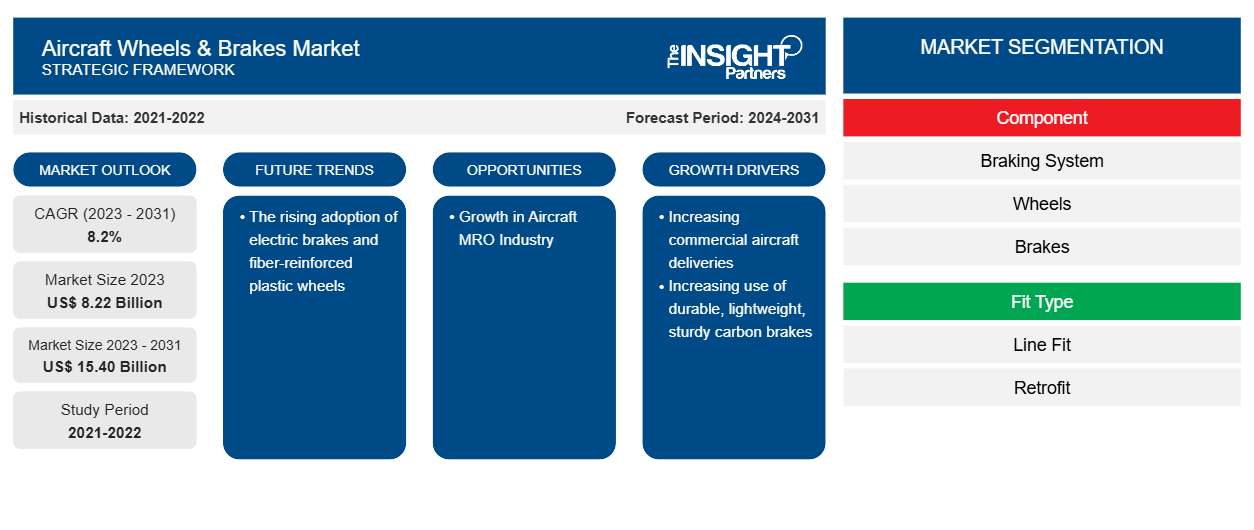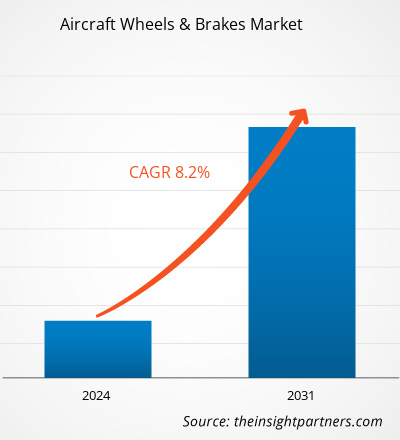The aircraft wheels & brakes market size is projected to reach US$ 15.40 billion by 2031 from US$ 8.22 billion in 2023. The market is expected to register a CAGR of 8.2% during 2023–2031. The rising adoption of electric brakes and fiber-reinforced plastic wheels is likely to remain a key trend in the market.
Aircraft Wheels & Brakes Market Analysis
The aircraft wheels and brakes market is majorly dominated by well-established players such as Honeywell International Inc, Parker Hannifin Corporation, Safran Group, and Crane Aerospace & Electronics among others. The demand for wheels and brakes among aircraft manufacturers is strongly increasing. However, most of the contracts are awarded to well-established players. Additionally, the manufacturing of these wheels and brakes requires compliance with several standards set by the governing authority. This involves obtaining various certifications and significant investments in R&D, which restricts the entrance of the new players in the field. Thus, the threat to business of new entrants is high in the current scenario; however, with the rise in aircraft production volume, the emergence of new players is foreseen. This is expected to lower the threat to new entrants as several smaller or mid-sized aircraft manufacturers would be procuring their wheels and brakes from new entrants offering advanced technology wheels and brakes at a competitive price.
Aircraft Wheels & Brakes Market Overview
The aircraft wheels and brakes market ecosystem comprise of following stakeholders- raw material and component providers, aircraft wheels and brakes manufacturers, aircraft manufacturers, and end-users. The aircraft wheels and brakes manufacturers procure raw materials and components such as steel, aluminum, magnesium alloy, and carbon fiction materials among others and components such as sensors and actuators among others are from various raw material and component providers. Aircraft wheels and brakes manufacturers assemble raw materials and components and produces into a finished goods. The aircraft wheel and brake manufacturers work in tandem with aviation authorities, raw material suppliers, aircraft manufacturers, and the end users. Few of the prominent players who are operation in the market are Collins Aerospace, Honeywell International Inc, Safran Group, and Parker Hannifin Corporation among others. Further, the aircraft manufacturers procure wheels and brakes from above mentioned players and installs the same on aircraft fleet through line fit activity. Finally, the end-users such as airline companies, various countries armed forces, and MRO service providers acquires contracts for aircraft wheel and brake MRO activity. The MRO service providers continuously procure wheels and brakes from the market players in order to continuously offer their services to ever-rising demand for aircraft wheel and brake MRO.
Customize This Report To Suit Your Requirement
You will get customization on any report - free of charge - including parts of this report, or country-level analysis, Excel Data pack, as well as avail great offers and discounts for start-ups & universities
Aircraft Wheels & Brakes Market: Strategic Insights

-
Get Top Key Market Trends of this report.This FREE sample will include data analysis, ranging from market trends to estimates and forecasts.
Aircraft Wheels & Brakes Market Drivers and Opportunities
Increasing Commercial Aircraft Deliveries
The rising commercial aircraft deliveries across different regions is driving the growth of wheels and brakes market. The production of commercial aircraft in large numbers is generating the demand for installation of new wheels and brakes across different regions. For instance, Airbus delivered around 735 aircraft in 2023 and witnessed an 11% hike compared to the 2022 deliveries. Moreover, the rise in global commercial aircraft fleet is further driving the growth for wheels and brakes worldwide. For instance, according to The Insight Partners’ secondary research the global commercial aircraft fleet in 2023 was around 27,385 that further reached to 28,398 aircaft in 2024. Such factors have been driving the adoption of aircraft wheels and brakes installation across the world.
Growth in Aircraft MRO Industry
With the rapidly growing aviation industry from the past few years, the demand for airline MRO services is also increasing. Emerging economies, such as those in APAC, are highly focused on extending MRO services to commercial as well as military aircrafts. Economic growth, increasing air passengers, and growing aviation infrastructure spending in APAC countries are the major factors driving the growth of the aircraft MRO services, which is subsequently providing lucrative opportunities for the growth of the aircraft wheels and brakes market. Moreover, accordinto The Insight Partner’s Analysis, the global aircraft MRO industry is likely to surpass US$ 140 billion by the end of 2034 which is further likely to generate new demand for aircraft wheels and brakes in the coming years.
Aircraft Wheels & Brakes Market Report Segmentation Analysis
Key segments that contributed to the derivation of the aircraft wheels & brakes market analysis are component, fit type, and end user.
- Based on component, the aircraft wheels & brakes market is segmented into braking system, wheels, and brakes. The brakes segment held a larger market share in 2023.
- Based on fit type, the aircraft wheels & brakes market is segmented into line fit and retrofit. The retrofit segment held a larger market share in 2023.
- Based on end user, the aircraft wheels & brakes market is segmented into defense and commercial. The commercial segment held a larger market share in 2023.
Aircraft Wheels & Brakes Market Share Analysis by Geography
The geographic scope of the aircraft wheels & brakes market report is mainly divided into five regions: North America, Europe, Asia Pacific, Middle East & Africa, and South America.
Asia Pacific has dominated the market in 2023 followed by North America and Europe regions. Further, Asia Pacific is also likely to witness highest CAGR in the coming years. China dominated the Asia Pacific aircraft wheels & brakes market in 2023. The demand for wheels and brakes market in China is mainly driven by the demand generated from MRO operations for the large number of fleet. For instance, in 2024, the commercial aircraft fleet across China stood at 4,126 which is further likely to reach around 6,429 aircraft by 2034. Moreover, according to the Airbus forecasts, more than 9,000 aircraft are likely to be delivered across China during 2023 to 2042. Such factors are likely to generate new opportunities for market vendors in the coming years.
Aircraft Wheels & Brakes Market Report Scope
Aircraft Wheels & Brakes Market Regional InsightsThe regional trends and factors influencing the Aircraft Wheels & Brakes Market throughout the forecast period have been thoroughly explained by the analysts at The Insight Partners. This section also discusses Aircraft Wheels & Brakes Market segments and geography across North America, Europe, Asia Pacific, Middle East and Africa, and South and Central America.
Aircraft Wheels & Brakes Market Report Scope
| Report Attribute | Details |
|---|---|
| Market size in 2023 | US$ 8.22 Billion |
| Market Size by 2031 | US$ 15.40 Billion |
| Global CAGR (2023 - 2031) | 8.2% |
| Historical Data | 2021-2022 |
| Forecast period | 2024-2031 |
| Segments Covered |
By Component
|
| Regions and Countries Covered |
North America
|
| Market leaders and key company profiles |
|
Aircraft Wheels & Brakes Market Players Density: Understanding Its Impact on Business Dynamics
The Aircraft Wheels & Brakes Market is growing rapidly, driven by increasing end-user demand due to factors such as evolving consumer preferences, technological advancements, and greater awareness of the product's benefits. As demand rises, businesses are expanding their offerings, innovating to meet consumer needs, and capitalizing on emerging trends, which further fuels market growth.

- Get the Aircraft Wheels & Brakes Market top key players overview
Aircraft Wheels & Brakes Market News and Recent Developments
The aircraft wheels & brakes market is evaluated by gathering qualitative and quantitative data post primary and secondary research, which includes important corporate publications, association data, and databases. A few of the developments in the aircraft wheels & brakes market are listed below:
- Safran Landing Systems inaugurated, on its Vélizy-Villacoublay site (France), an entirely revamped laboratory dedicated to testing its wheels and carbon brakes, and equipped with a new test bench. The company will have invested a total of 10 million euros to carry out this ambitious project. The result is a responsible working environment and the promise to reinforce the Safran's ability to develop and qualify higher-performance, more durable and competitive brakes as well as to keep pace with its customers’ ramp ups. This applies to almost all segments of civil, military and business aviation. (Source: Safran, Press Release, Apr 2024)
- Parker-Hannifin Corporation (NYSE: PH, “Parker”), the global leader in motion and control technologies, today announced that it has completed its previously announced transaction to sell its Aircraft Wheel and Brake Division, located in Avon, Ohio, in the United States, to Kaman Corporation (NYSE: KAMN). Kaman, headquartered in Bloomfield, Connecticut, is a leading manufacturer of components and materials for aerospace and defense, industrial and medical markets. (Source: Parker-Hannifin Corporation, Press Release, Sep 2022)
Aircraft Wheels & Brakes Market Report Coverage and Deliverables
The “Aircraft Wheels & Brakes Market Size and Forecast (2021–2031)” report provides a detailed analysis of the market covering below areas:
- Aircraft wheels & brakes market market size and forecast at global, regional, and country levels for all the key market segments covered under the scope
- Aircraft wheels & brakes market market trends as well as market dynamics such as drivers, restraints, and key opportunities
- Detailed porter’s five forces analysis
- Aircraft wheels & brakes market market analysis covering key market trends, global and regional framework, major players, regulations, and recent market developments
- Industry landscape and competition analysis covering market concentration, heat map analysis, prominent players, and recent developments for the aircraft wheels & brakes market
- Detailed company profiles
Frequently Asked Questions
What is the expected CAGR of the aircraft wheels & brakes market ?
What would be the estimated value of the aircraft wheels & brakes market by 2031?
What are the future trends of the aircraft wheels & brakes market ?
Which are the leading players operating in the aircraft wheels & brakes market ?
What are the driving factors impacting the aircraft wheels & brakes market ?
Which region dominated the aircraft wheels & brakes market in 2023?
- Historical Analysis (2 Years), Base Year, Forecast (7 Years) with CAGR
- PEST and SWOT Analysis
- Market Size Value / Volume - Global, Regional, Country
- Industry and Competitive Landscape
- Excel Dataset
Recent Reports
Related Reports
Testimonials
Reason to Buy
- Informed Decision-Making
- Understanding Market Dynamics
- Competitive Analysis
- Identifying Emerging Markets
- Customer Insights
- Market Forecasts
- Risk Mitigation
- Boosting Operational Efficiency
- Strategic Planning
- Investment Justification
- Tracking Industry Innovations
- Aligning with Regulatory Trends





















 Get Free Sample For
Get Free Sample For